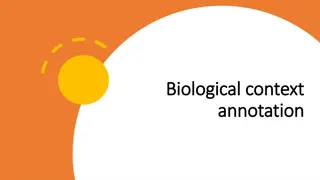
Efficient Software Design and Implementation Strategies for Performance and Scalability
Explore the challenges of scaling software structures and discover design exercises to enhance user experience and prevent Repetitive Strain Injury. Learn about events, listeners, and callbacks in software design to optimize performance.
Download Presentation

Please find below an Image/Link to download the presentation.
The content on the website is provided AS IS for your information and personal use only. It may not be sold, licensed, or shared on other websites without obtaining consent from the author. If you encounter any issues during the download, it is possible that the publisher has removed the file from their server.
You are allowed to download the files provided on this website for personal or commercial use, subject to the condition that they are used lawfully. All files are the property of their respective owners.
The content on the website is provided AS IS for your information and personal use only. It may not be sold, licensed, or shared on other websites without obtaining consent from the author.
E N D
Presentation Transcript
CSE 331 Software Design & Implementation Dan Grossman Fall 2014 Events, Listeners, and Callbacks (Based on slides by Mike Ernst, David Notkin, Hal Perkins)
The limits of scaling What prevents us from building huge, intricate structures that work perfectly and indefinitely? No friction No gravity No wear-and-tear it s the difficulty of understanding them So we split designs into sensible parts and reduce interaction among the parts More cohesion within parts Less coupling across parts CSE331 Fall 2014 2
Design exercise #1 Write a typing-break reminder program Offer the hard-working user occasional reminders of the perils of Repetitive Strain Injury, and encourage the user to take a break from typing. Naive design: Make a method to display messages and offer exercises Make a loop to call that method from time to time (Let's ignore multithreaded solutions for this discussion) CSE331 Fall 2014 3
TimeToStretch suggests exercises public class TimeToStretch { public void run() { System.out.println("Stop typing!"); suggestExercise(); } public void suggestExercise() { } } CSE331 Fall 2014 4
Timer calls run() periodically public class Timer { private TimeToStretch tts = new TimeToStretch(); public void start() { while (true) { ... if (enoughTimeHasPassed) { tts.run(); } ... } } } CSE331 Fall 2014 5
Main class puts it together class Main { public static void main(String[] args) { Timer t = new Timer(); t.start(); } } This program, as designed, will work... But we can do better CSE331 Fall 2014 6
Module dependency diagram (MDD) An arrow in a module dependency diagram (MDD) indicates depends on or knows about Simplistically: any name mentioned in the source code Main depends on Timer Main Timer TimeToStretch Timer depends on TimeToStretch What s wrong with this diagram? Does Timer really need to depend on TimeToStretch? Is Timer re-usable in a new context? CSE331 Fall 2014 7
Decoupling Timer needs to call the run method Timer does not need to know what the run method does Weaken the dependency of Timer on TimeToStretch Introduce a weaker specification, in the form of an interface or abstract class public abstract class TimerTask { public abstract void run(); } Timer only needs to know that something (e.g., TimeToStretch) meets the TimerTask specification CSE331 Fall 2014 8
TimeToStretch (version 2) public class TimeToStretch extends TimerTask { public void run() { System.out.println("Stop typing!"); suggestExercise(); } public void suggestExercise() { ... } } CSE331 Fall 2014 9
Timer (version 2) public class Timer { private TimerTask task; public Timer(TimerTask task) { this.task = task; } public void start() { while (true) { ... task.run(); } } } Main creates a TimeToStretch object and passes it to Timer: Timer t = new Timer(new TimeToStretch()); t.start(); CSE331 Fall 2014 10
Module dependency diagram (version 2) Timer depends on TimerTask, not TimeToStretch Unaffected by implementation details of TimeToStretch Now Timer is much easier to reuse Main depends on the constructor for TimeToStretch Main still depends on Timer (is this necessary?) Main TimerTask Timer Dependence TimeToStretch Subclassing CSE331 Fall 2014 11
The callback design pattern TimeToStretch creates a Timer, and passes in a reference to itself so the Timer can call it back This is a callback a method call from a module to a client that it notifies about some condition Use a callback to invert a dependency Inverted dependency: TimeToStretch depends on Timer (not vice versa) Less obvious coding style, but more natural dependency Side benefit: Main does not depend on Timer CSE331 Fall 2014 12
Callbacks Callback: Code provided by client to be used by library In Java, pass an object with the code in a method Synchronous callbacks: Examples: HashMapcalls its client s hashCode, equals Useful when library needs the callback result immediately Asynchronous callbacks: Examples: GUI listeners Register to indicate interest and where to call back Useful when the callback should be performed later, when some interesting event occurs CSE331 Fall 2014 13
TimeToStretch (version 3) public class TimeToStretch extends TimerTask { private Timer timer; public TimeToStretch() { timer = new Timer(this); } public void start() { timer.start(); } public void run() { System.out.println("Stop typing!"); suggestExercise(); } ... } Register interest with the timer Callback entry point CSE331 Fall 2014 14
Main (version 3) TimeToStretch tts = new TimeToStretch(); tts.start(); Uses a callback in TimeToStretchto invert a dependency This MDD shows the inversion of the dependency between Timer and TimeToStretch (compare to version 1) Main does not depend on Timer TimeToStretch depends on Timer Main TimerTask Timer TimeToStretch CSE331 Fall 2014 15
Decoupling and design A good design has dependences (coupling) only where it makes sense While you design (before you code), examine dependences Don t introduce unnecessary coupling Coupling is an easy temptation if you code first Suppose a method needs information from another object: If you hack in a way to get it: The hack might be easy to write It will damage the code s modularity and reusability More complex code is harder to understand CSE331 Fall 2014 16
Design exercise #2 A program to display information about stocks Stock tickers Spreadsheets Graphs Naive design: Make a class to represent stock information That class updates all views of that information (tickers, graphs, etc.) when it changes CSE331 Fall 2014 17
Module dependency diagram Main class gathers information and stores in Stocks Stocks class updates viewers when necessary Main Stocks StockTicker Spreadsheet StockGraph Problem: To add/change a viewer, must change Stocks Better: insulate Stocks from the vagaries of the viewers CSE331 Fall 2014 18
Weaken the coupling What should Stocks class know about viewers? Only needs an update method to call with changed data Old way: void updateViewers() { ticker.update(newPrice); spreadsheet.update(newPrice); graph.update(newPrice); // Edit this method to // add a new viewer. } CSE331 Fall 2014 19
Weaken the coupling What should Stocks class know about viewers? Only needs an update method to call with changed data New way: The observer pattern interface PriceObserver { void update(PriceInfo pi); } class Stocks { private List<PriceObserver> observers; void addObserver(PriceObserver pi) { observers.add(pi); } void notifyObserver(PriceInfo i) { for (PriceObserver obs : observers) obs.update(i); } } Register a callback Do the callbacks CSE331 Fall 2014 20
The observer pattern Stocks not responsible for viewer creation Main passes viewers to Stocks as observers Stocks keeps list of PriceObservers, notifies them of changes Create viewers and get observers Main Create Stocks and add observers PriceObserver Stocks StockTicker Create (or be) observers Spreadsheet StockGraph Issue: update method must pass enough information to (unknown) viewers CSE331 Fall 2014 21
A different design: pull versus push The Observer pattern implements push functionality A pull model: give viewers access to Stocks, let them extract the data they need new(Stocks) Main Stocks.new Stocks StockTicker Spreadsheet StockGraph Push versus pull efficiency can depend on frequency of operations (Also possible to use both patterns simultaneously.) CSE331 Fall 2014 22
Another example of Observer pattern // Represents a sign-up sheet of students public class SignupSheet extends Observable { private List<String> students = new ArrayList<String>(); public void addStudent(String student) { students.add(student); setChanged(); notifyObservers(); } public int size() { return students.size(); } } protected void setChanged() void notifyObservers() Part of the JDK SignupSheet inherits many methods including: void addObserver(Observer o) CSE331 Fall 2014 23
An Observer Part of the JDK public class SignupObserver implements Observer { // called whenever observed object changes // and observers are notified public void update(Observable o, Object arg) { System.out.println("Signup count: " + ((SignupSheet)o).size()); } } Not relevant to us cast because Observable is non-generic CSE331 Fall 2014 24
Registering an observer SignupSheet s = new SignupSheet(); s.addStudent("billg"); // nothing visible happens s.addObserver(new SignupObserver()); s.addStudent("torvalds"); // now text appears: "Signup count: 2" Java's Listeners (particularly in GUI classes) are examples of the Observer pattern (Feel free to use the Java observer classes in your designs if they are a good fit but you don t have to use them) CSE331 Fall 2014 25
User interfaces: appearance vs. content It is easy to tangle up appearance and content Particularly when supporting direct manipulation (e.g., dragging line endpoints in a drawing program) Another example: program state stored in widgets in dialog boxes Neither can be understood easily or changed easily This destroys modularity and reusability Over time, it leads to bizarre hacks and huge complexity Code must be discarded Callbacks, listeners, and other patterns can help CSE331 Fall 2014 26






















